#ca. 5300 b.c.
Note
Can you make a post about the evolution of Greek art from the ancient times until now in modern age?
Because we often talk about the evolution of art but unfortunately we don't appreciate after ancient times the other art movements Greece went through the centuries.
That’s true! I am sorry for taking ages to answer this but I don't know how it could take me less anyway hahaha I made this post with summaries about all artistic eras in Greek history. I have most of it under a cut because with the addition of pictures it got super long, but if you are interested in the history of art I recommend giving it a try! I took advantage of all 30 pictures that can be possibly attached in a tumblr post and I tried to cover as many eras and art styles as possible, nearly dying in the process ngl XD I dedicated a few more pictures in modern art, a) because that was the ask and b) because there is more diversity in the styles that are used and the works that are available to us in great condition in modern times.
History of Greek Art
Greek Neolithic Art (c. 7000 - 3200 BC)
Obviously, with this term we don’t mean there were people identifying as Greeks in Neolithic times, but it defines the Neolithic art corresponding to the Greek territory. Art in this era is mostly functional, there are progressively more and more defined designs on clay pots, tools and other utility items. Clay and obsidian are the most used materials.
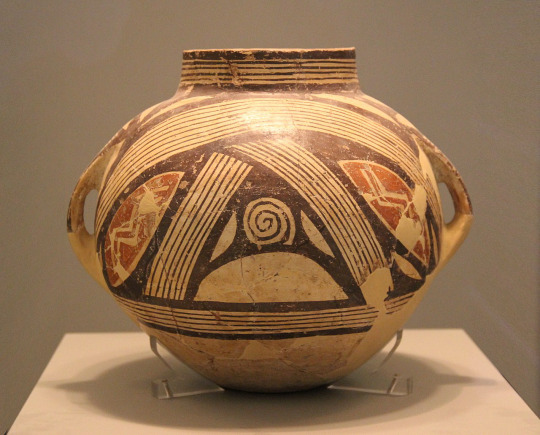
Clay vase with polychrome decoration, Dimini, Magnesia, Late or Final Neolithic (5300-3300 BC).
Cycladic Art (3300 - 1100 BC)
The art of the Cycladic civilisation of the Aegean Islands is characterized by the use of local marble for the creation of sculptures, idols and figurines which were often associated to womanhood and female deities. Cycladic art has a unique way of incidentally feeling very relevant, as it resembles modern minimalism.

Early Cycladic II (Keros-Syros culture, 2800–2300 BC)
Minoan Art (3000-1100 BC)
The advanced Minoan civilisation of Crete island was projecting its confidence and its vibrancy through its various arts. Minoan art was influenced by the earlier Egyptian and Near East cultures nearby and at its peak it overshadowed the rest of the contemporary cultures and their artistic movements in Greece. Colourful, with numerous scenes of everyday life and island life next to the sea, it was telling of the society’s prosperity.

The Bull-leaping fresco from Knossos, 1450 BC.
Mycenaean Art (c. 1750 - 1050 BC)
Mycenaean Art was very influenced by Minoan Art. Mycenaean art diverged and distinguished itself more in warcraft, metalwork, pottery and the use of gold. Even when similar, you can tell them apart from their themes, as Mycenaean art was significantly more war-centric.
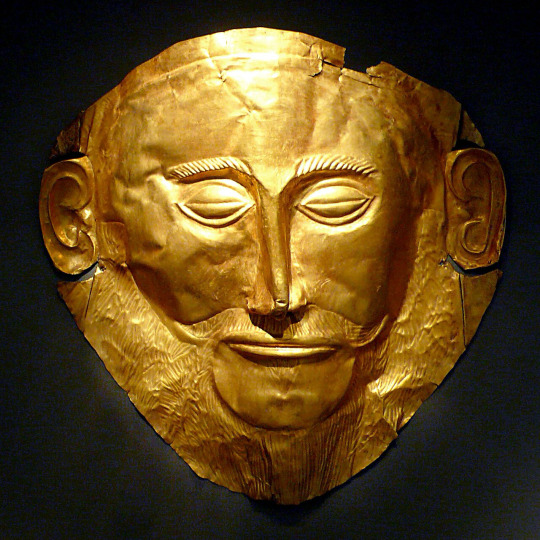
The Mask of Agamemnon in the National Archaeological Museum of Athens. The mask likely was crafted around 1550 BC so it predates the time Agamemnon perhaps lived.
Geometric Art (1100 - 700 BC)
Corresponding to a period we have comparatively too little data about, the Geometric Period or the Homeric Age or the Greek Dark Ages, geometric art was characterized by the extensive use of geometric motifs in ceramics and vessels. During the late period, the art becomes narrative and starts featuring humans, animals and scenes meant to be interpreted by the viewer.

Detail from Geometric Krater from Dipylon Cemetery, Athens c. 750 BC Height 4 feet (Metropolitan Museum, New York)
Archaic Art (c. 800 - 480 BC)
The art of the archaic period became more naturalistic and representational. With eastern influences, it diverged from the geometric patterns and started developing more the black-figure technique and later the red-figure technique. This is also the earliest era of monumental sculpture.
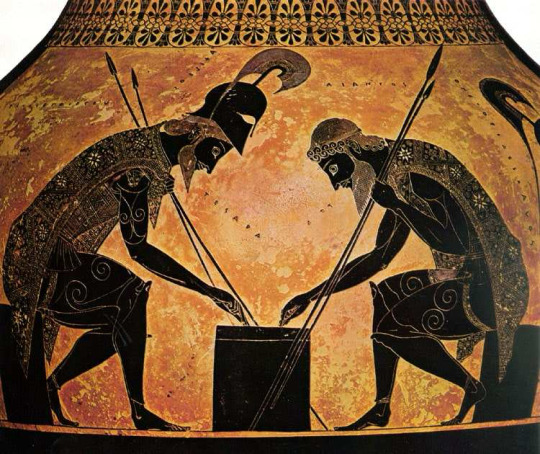
Achilles and Ajax Playing a Board Game by Exekias, black-figure, ca. 540 B.C.
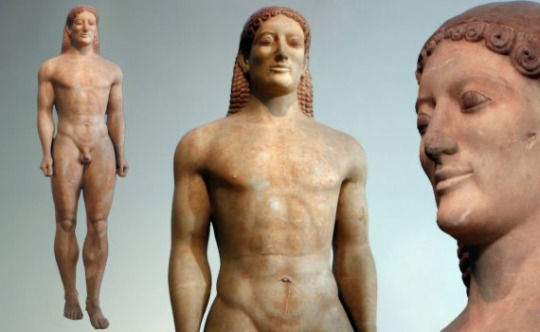
Kroisos Kouros, c. 530 B.C.
Classical Art (c. 480 - 323 BC)
Art in this era obtained a vitality and a sense of harmony. There is tremendous progress in portraying the human body. Red-figure technique definitively overshadows the use of the black-figure technique. Sculptures are notable for their naturalistic design and their grandeur.
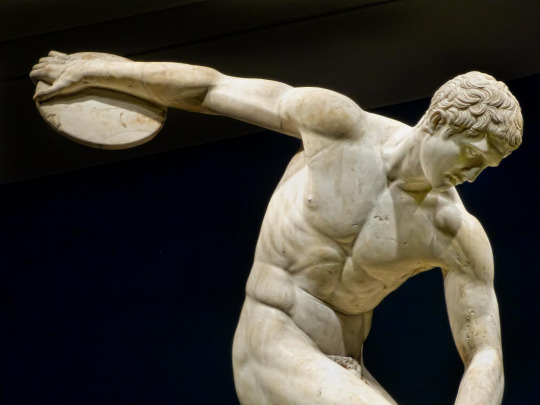
The Diskobolos or Discus Thrower, Roman copy of a 450-440 BCE Greek bronze by Myron recovered from Emperor Hadrian’s Villa in Tivoli, Italy. (British Museum, London). Photo by Mary Harrsch.

Terracotta bell-krater, Orpheus among the Thracians, ca. 440 BCE, The Metropolitan Museum of Art.
Hellenistic Art (323 - 30 BCE)
Hellenistic art perfects classical art and adds more diversity and nuance to it, something that can be explained by the rapid geographical expansion of Greek influence through Alexander’s conquests. Sculpture, painting and architecture thrived whereas there is a decrease in vase painting. The Corinthian style starts getting popular. Sculpture becomes even more naturalistic and expresses emotion, suffering, old age and various other states of the human condition. Statues become more complex and extravagant. Everyday people start getting portrayed in art and sculpture without extreme beauty standards imposed. We know there was a huge rise in wall painting, landscape art, panel painting and mosaics.

Mosaic from Thmuis, Egypt, created by the Ancient Greek artist Sophilos (signature) in about 200 BC, now in the Greco-Roman Museum in Alexandria, Egypt. The woman depicted in the mosaic is the Ptolemaic Queen Berenike II (who ruled jointly with her husband Ptolemy III) as the personification of Alexandria.

Agesander, Athenodore and Polydore: Laocoön and His Sons, 1st century BC
Greco-Roman Art (30 BC - 330 AD)
This period is characterized by the almost entire and mutually influential merging of Greek and Roman artistic expression, in light of the Roman conquest of the Hellenistic world. For this era, it is hard to find sources exclusively for Greek art, as often even art crafted by Greeks of the Roman Empire is described as Roman. In general, Greco-Roman art reinforces the new elements of Hellenistic art, however towards the end of the era, with the rise of early Christianity in the Eastern aka the Greek-influenced part of the empire, there are some gradual shifts in the art style towards modesty and spirituality that will in time lead to the Byzantine art. During this era mosaics become more loved than ever.
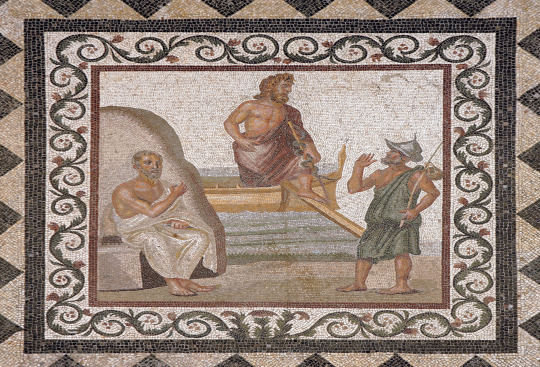
A mosaic from the island of Kos (the birthplace of Hippocrates) depicting Hippocrates (seated) and a fisherman greeting the god Asklepios (center) as he either arrives or disembarks from the island. Second or third century CE.
Introduction to Byzantine Art
Byzantine art originated and evolved from the now Christian Greek culture of the Eastern Roman Empire. Although the art produced in the Byzantine Empire was marked by periodic revivals of a classical aesthetic, it was above all marked by the development of a new aesthetic defined by its salient "abstract", or anti-naturalistic character. If classical art was marked by the attempt to create representations that mimicked reality as closely as possible, Byzantine art seems to have abandoned this attempt in favor of a more symbolic approach. The subject matter of monumental Byzantine art was primarily religious and imperial: the two themes are often combined.
Early Byzantine Art (330 - 842 AD)
The establishment of the Christian religion results in a new artistic movement, centered around the faith. However, ancient statuary remains appreciated. Most fundamental changes happen in monumental architecture, the illustration of manuscripts, ivory carving and silverwork. Exceptional mosaics become integral in artistic expression. The last 100 years of this period are defined by the Iconoclasm, which temporarily restricts entirely the previously thriving figural religious art.

Mosaics in the Rotunda of Thessaloniki, 4th - 6th century AD.
Macedonian Art & Komnenian Age (843 - 1204 AD)
These artistic periods correspond to the middle Byzantine period. After the end of the Iconoclasm, there is a revival in the arts. The art of this period is frequently called Macedonian art, because it occurred during the Macedonian imperial dynasty which generally brought a lot of prosperity in the empire. There was a revival of interest in the depiction of subjects from classical Greek mythology and in the use of Hellenistic styles to depict religious subjects. The Macedonian period also saw a revival of the late antique technique of ivory carving. The following Komnenian dynasty were great patrons of the arts, and with their support Byzantine artists continued to move in the direction of greater humanism and emotion. Ivory sculpture and other expensive mediums of art gradually gave way to frescoes and icons, which for the first time gained widespread popularity across the Empire. Apart from painted icons, there were other varieties - notably the mosaic and ceramic ones.
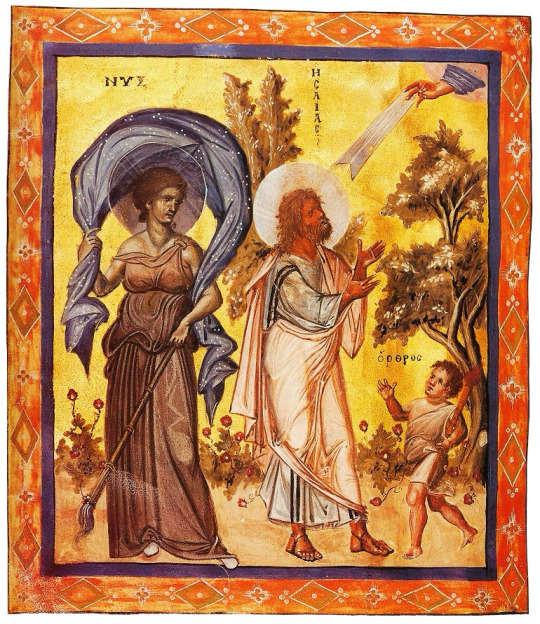
Paris Psalter, 10th century AD. Prophet Isaiah from the Old Testament in the company of the symbolisms for night (clear inspiration drawn from the ancient deity Nyx) and morning (Orthros, not to be confused with the mythological creature).
Palaeologan Renaissance (1261 - 1453)
The Palaeologan Renaissance is the final period in the development of Byzantine art. Coinciding with the reign of the Palaeologi, the last dynasty to rule the Byzantine Empire (1261–1453), it was an attempt to restore Byzantine self-confidence and cultural prestige after the empire had endured a long period of foreign occupation. The legacy of this era is observable both in Greek culture after the empire's fall and in the Italian Renaissance. Contemporary trends in church painting favored intricate narrative cycles, both in fresco and in sequences of icons. The word "icon" became increasingly associated with wooden panel painting, which became more frequent and diverse than fresco and mosaics. Small icons were also made in quantity, most often as private devotional objects.
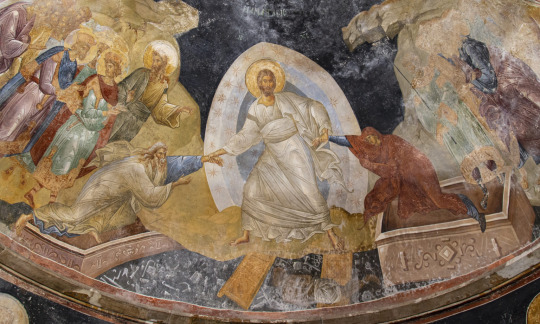
Detail of Anástasis (Resurrection) fresco, c. 1316–1321, Chora church, Constantinople (Istanbul) (photo: byzantologist).
Cretan School (15th - 17th century)
Cretan School describes an important school of icon painting, under the umbrella of post-Byzantine art, which flourished while Crete was under Venetian rule during the Late Middle Ages, reaching its climax after the Fall of Constantinople, becoming the central force in Greek painting during the 15th, 16th and 17th centuries. By the late 15th century, Cretan artists had established a distinct icon-painting style, distinguished by "the precise outlines, the modelling of the flesh with dark brown underpaint, the bright colours in the garments, the geometrical treatment of the drapery and, finally, the balanced articulation of the composition". Contemporary documents refer to two styles in painting: the maniera greca (in line with the Byzantine idiom) and the maniera latina (in accordance with Western techniques), which artists knew and utilized according to the circumstances. Sometimes both styles could be found in the same icon. The most famous product of the school was the painter Domenikos Theotokopoulos, internationally known as El Greco, whose art evolved and diverged significantly in his later years when he moved in Spain and was involved in the Spanish Renaissance, and though it often alienated his western contemporary artists, nowadays it is viewed as an incidental early birth of Impressionism in the mid of the Renaissance’s peak.

Icon by Andreas Pavias (1440-1510), Cretan School, from Candia (Venetian Kingdom of Crete). The Latin inscription suggests the icon was meant for commercial purposes in Western Europe. National Museum, Athens. (Source: https://russianicons.wordpress.com/tag/cretan-school/)

Crucifixion (detail), El Greco (Doménikos Theotokópoulos), ca. 1604 - 1614.
Heptanesian School (17th - 19th century)
The Heptanesian school succeeded the Cretan School as the leading school of Greek post-Byzantine painting after Crete fell to the Ottomans in 1669. Like the Cretan school, it combined Byzantine traditions with an increasing Western European artistic influence and also saw the first significant depiction of secular subjects. The center of Greek art migrated urgently to the Heptanese (Ionian) islands but countless Greek artists were influenced by the school including the ones living throughout the Greek communities in the Ottoman Empire and elsewhere in the world. Greek art was no longer limited to the traditional maniera greca dominant in the Cretan School. Furthermore, the Heptanesian school was the basis for the emergence of new artistic movements such as the Greek Rocco and Greek Neoclassicism. The movement featured a mixture of brilliant artists.

Archangel Michael, Panagiotis Doxaras, 18th century.
Greek Romanticism (19th century)
Modern Greek art, after the establishment of the Greek Kingdom, began to be developed around the time of Romanticism. Greek artists absorbed many elements from their European colleagues, resulting in the culmination of the distinctive style of Greek Romantic art, inspired by revolutionary ideals as well as the country's geography and history.

Vryzakis Theodoros, The Exodus from Missolonghi, 1853. National Gallery, Athens.
The Munich School (19th century Academic Realism)
After centuries of Ottoman rule, few opportunities for an education in the arts existed in the newly independent Greece, so studying abroad was imperative for artists. The most important artistic movement of Greek art in the 19th century was academic realism, often called in Greece "the Munich School" because of the strong influence from the Royal Academy of Fine Arts of Munich where many Greek artists trained. In academic realism the imperative is the ethography, the representation of urban and/or rural life with a special attention in the depiction of architectural elements, the traditional cloth and the various objects. Munich School painters were specialized on portraiture, landscape painting and still life. The Munich school is characterized by a naturalistic style and dark chiaroscuro. Meanwhile, at the time we observe the emergence of Greek neoclassicism and naturalism in sculpture.

Nikolaos Gyzis, Learning by heart, 1883.
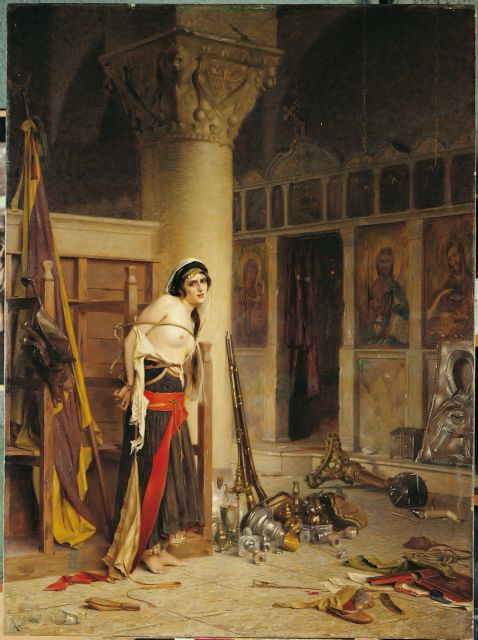
Rallis Theodoros, The Booty, before 1906.
20th Century Modern & Contemporary Greek Art
At the beginning of the 20th century the interest of painters turned toward the study of light and color. Gradually the impressionists and other modern schools increased their influence. The interest of Greek painters, artists changes from historical representations to Greek landscapes with an emphasis on light and colours so abundant in Greece. Representatives of this artistic change introduce historical, religious and mythological elements that allow the classification of Greek painting into modern art. The era of the 1930s was a landmark for the Greek painters. The second half of the 20th century has seen a range of acclaimed Greek artists too serving the movements of surrealism, metaphysical art, kinetic art, Arte Povera, abstract excessionism and kinetic sculpture.
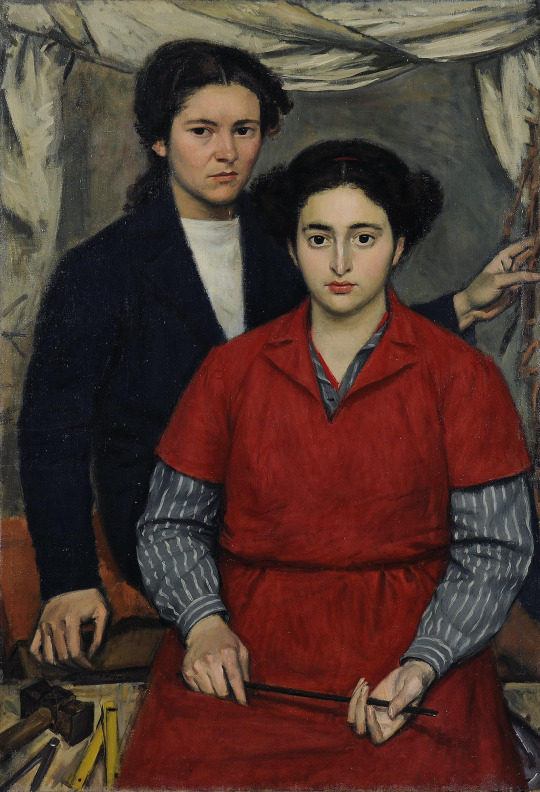
Yiannis Moralis, Two friends, 1946.

Art by Giannis Gaitis (1923-1984), famous for his uniformed little men.

By Yorghos Stathopoulos (1944 - )
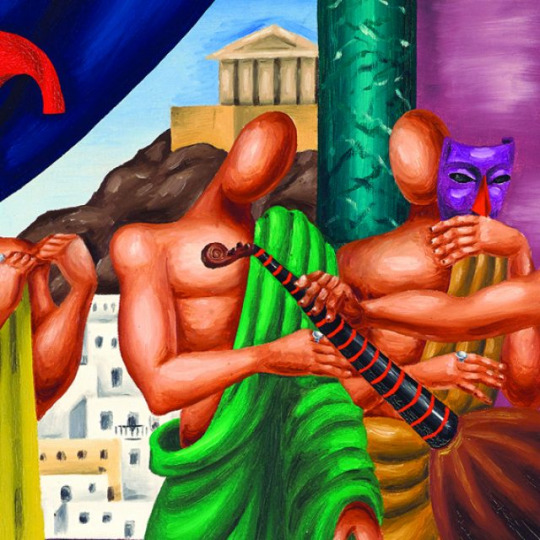
Art (detail) by Nikos Engonopoulos (1907 - 1985)
Folk, Modern Ecclesiastical and Secular Post-Byzantine Art
Ecclesiastical art, church architecture, holy painting and hymnology follow the order of Greek Byzantine tradition intact. Byzantine influence also remained pivotal in folk and secular art and it currently seems to enjoy a rise in national and international interest about it.

A modern depiction of the legendary hero Digenes Akritas depicted in the style of a Byzantine icon by Greek artist Dimitrios Skourtelis. Credit: Dimitrios Skourtelis / Reddit

Erotokritos and Aretousa by folk artist Theophilos (1870-1934)

Example of Modern Greek Orthodox murals, Church of St. Nicholas.

Ancient Greek philosophers depicted in iconographic fashion in one of Meteora’s monasteries. Each is holding a quote from his work that seems to foreshadow Christ. Shown from left to right are: Homer, Thucydides, Aristotle, Plato and Plutarch. This is not as weird as it may initially seem: it was a recurrent belief throughout the history of Christian Greek Orthodoxy that the great philosophers of the world heralded Jesus' birth in their writings - it was part of the eras of biggest reconciliation between Greek Byzantinism and Classicism.

Prophet Elijah icon with Chariot of Fire, Handmade Greek Orthodox icon, unknown iconographer. Source
If you see this, thanks very much for reading this post. Hope you enjoyed!
#greece#art#europe#history#culture#greek art#artists#greek culture#history of art#classical art#ancient greek art#byzantine greek art#christian art#orthodox art#modern art#modern greek art#anon#ask
57 notes
·
View notes
Text
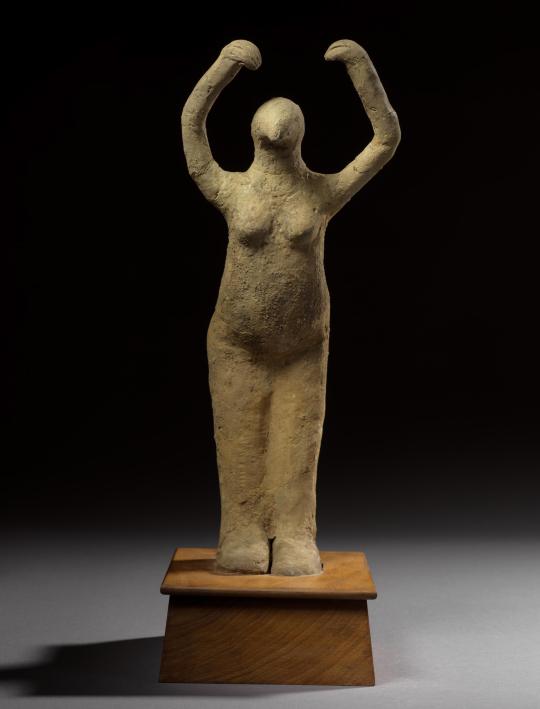



~ Figure of standing female with upraised arms.
Place oforigin: Upper Egypt
Date: ca. 5300-4000 B.C.
Period: Early Predynastic Period
Medium: Unbaked clay
#ancient#ancient sculpture#ancient art#ancient egypt#ancient Egyptian#ancient figure#ancient history#history#archaeology#museum#standing female figure#upraised arms#early Predynastic period#Predynastic#Egypt#egyptian#egyptology#Unbaked clay#ca. 5300 b.c.#ca. 4000 b.c.
486 notes
·
View notes
Text
The reason for publishing a short catalogue is to facilitate easier and cheaper shipping so that I can ship anyone who asks for one will get one quickly.
If you usually get my catalogues one will be on the way, If you would like one please e-mail or text me. I hope you enjoy it.
James
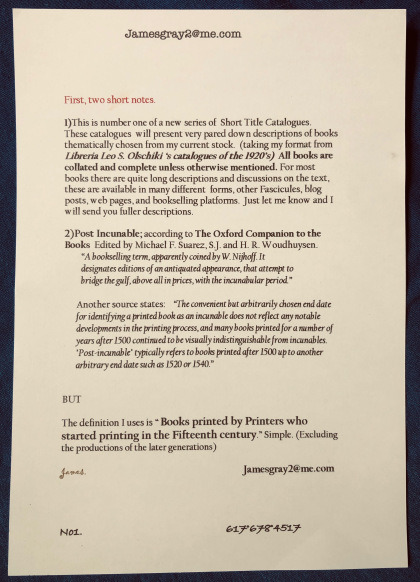

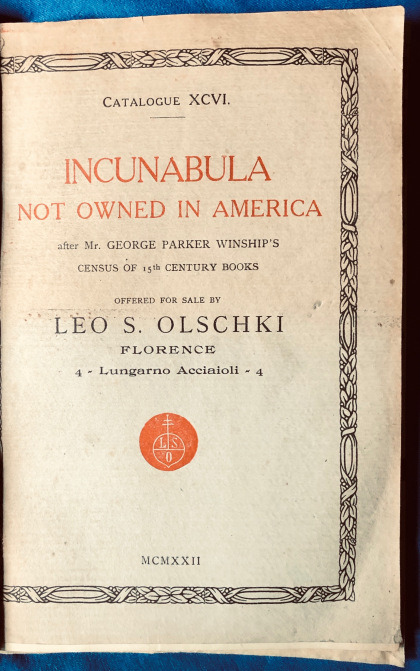
1) 269J Thomas Aquinas 1225-1274
Summa theologiae: Pars prima. Ed: Franciscus de Neritono, Petrus Cantianus, and Joannes Franciscus.
Venice: [Nicolaus Jenson] 1477. $ 18,000
Folio. Full contemporary calf over wooden boards, rubricated through- out. This is the second edition of the ‘pars prima”, the first was 1473. The Summa was written 1265–1274 and also known as the Summa Theologica or simply the Summa) is the best-known work of Thomas Aquinas.
Goff T198; HC 1442*; Mich 118; Pell 1038; CIBN T-170; Zehnacker 2241; Castan(Besançon) 95; Polain(B) 4759; IGI 9573; IBP 5300; Sajó-Soltész 3263; IDL 4392; IBE 5623; IJL2 354; SI 3796; Coll(U) 1431; Madsen 4397; Voull(Trier) 1820; Voull(B) 3669; Ohly-Sack 2743; Sack(Freiburg) 3444; Borm 2610; Bod-inc T-167; Sheppard 3283; Pr 4103; BMC V 177; BSB-Ink T-273; GW M46455
2) 353J Sammelband Of Aristotle commentaries. 1499-1509
1)Petri Tatereti in Summulas Petri Hyspani 2)Necnon Methaphisice Aristotelis magistri Petri Tatareti exposition 3)Petri Tatereti super textu logices Aristotelis
1) [Lyons] : Claudii Davost al’s de troys,1509 2) Lyons Claudij Davost 1509. 3) Lyons; Davost or Wolf about 1499/1500. $15,000
Many woodcut illustrations. This is a rare incunabula (and post) editions of the commentary on Aristotle’s Logic by Petrus Tartaretus, follower of Duns Scotus and rector of theUniversity of Paris in 1490.
1) Panzer, VII,; p. 292, no. 141 Not in Adams or the BM STC, French Books..
2) USTC no.: 155038 Panzer, VII,; p. 292, no. 140
LIBRARY COPIES: Universitat de Barcelona , Det Kongelige Bibliotek, Oxford (UK), Wadham College Library : Not in Adams or the BM STC, French Books..
3) Goff T43 = T40; R 758; Pell Ms 10941; IGI V p.153; IBE Post-incunables 249; Sajó-Soltész p.952; Olivar 391; Sack(Freiburg) 3337a; Walsh 3835a; ISTC it00043000 United States 3 copies Harvard, Johns Hopkins, Smithsonian .
3) 284J Aristotle and Gualtherus Burlaeus. (Walter Burley)
Expositio Gualteri Burlei super decem Libros Ethicorum Aristotelis the Nicomachean Ethics
Venice: Andreas Torresanus, 1500 $10,500
Folio, Half calf over wooden boards. Second edition after that of 1481. There are two printed editions of this work, the one offered here is the second, the first is also quite rare-Goff B 1300, (3 copies)
Goff; B-1301; BM 15th cent. V, 576 (IB. 24667); GW; 5779; ; Hain-Copinger; *4144; Harman; 191; ISTC (online); ib01301000; Proctor; 5269; Pellechet; 3080
4) 198G Bernardus Basinus
De magicis artibus et magorum maleficiis
Paris : Antoine Caillaut, 1491-1492? ) $ 19,000
Quarto. Older limp vellum. Capitals supplied in Red and Blue .This treatise on magical practices was based on a speech Basin delivered in Paris before an assembly of cardinals in 1482.
Not in Goff: Dated by CIBN; Pell (Lyon) 40; Bod-inc B-132; Sheppard 6190; Pr 7967; BSB-Ink B-233; GW 3720; CIBN B-182; Aquilon 89; Parguez 146.
5) 144J A. M. T. Severinus Boethius
De disciplina scholarium (Comm: pseudo- Thomas Aquinas)
[Bound with]
Boetius de consolatione philosophie necnon de disciplina scholariu[m] cum creme[n]to [sic] sancti Thome De
consolatione philosophiae (with commentary ascribed in the text to Thomas Aquinas).
Lyon: Jean Du Pré, 1491/92 $ 7,000
Small Folio (second part lacking two leaves a1 title and a2 introduction) full vellum. A very rare impression
Goff B796 (one copy Harvard) ; Pell 2531; CIBN B-581; Frasson-Cochet 59; Parguez 232; IBE 1118; IGI 1835; IBPort 383; Mendes 278; Walsh 3779; GW 4554
6) 756G Diodorus
Bibliothecae historicae libri VI [a Poggio Florentino in latinum traductus]
[Paris] : [Denis Roce] Venundantur in vico sancti Iacobi sub signo diui Martini. (1505-08) $2,800
Approximate date of publication from Moreau, B. Inventaire chronologique des éditions parisiennes v. 1, p. 274
Octavo 19th century calf rebacked. Diodorus Siculus is the author of the ‘Bibliotheke’ or ‘Library,’ a universal history from mythological times to 60 B.C. Only fifteen of the original forty books survive fully (books one through five; eleven through twenty); the others are preserved in fragments.
Goff D215? ; Moreau I 274: 63; Renouard, Imprimeurs III 128 and I, 1508, 63; Renouard, 1005 (mark of D. Roce) Pell 4264; BMC(Fr) p.135
7) 312J. Domenico Cavalca. (1270?-1342)
Pungi language.
[Baptista de Tortis]: Venexia, Adi .viiii. de Octubrio. 1494 $17,000
Quarto Large woodcut depicting the crucifixion on the frontispiece, Rare first Venetian edition with the l woodblock published here for the first time. initial “A” in gold, blue, red and green, a colorful coat of arms.
Goff C342; H(Add)C 4776a; R 116; Pell 3448; CIBN C-195; IGI 2637; Essling 750; Sander 1853; Pr 4649; BMC V 328; GW 6413
One copy in Goff. Huntington Library.
Queried Location: New York NY, Manhattan College: sold Christie’s (NY) 1 June 1991 lot 41 (current whereabouts unknown)
8) 945G Eusebius of Caesarea c. 260-c. 340
Eusebius Pa[m]phili de eua[n]gelica preparac[i]o[n]e ex greco in latinu[m] translatus Incipit feliciter.
[ Cologne, Ulrich Zel, not after 1473] $18,000
Folio 152 of 152 leave. One of the earliest editions most likely the Second, (editio princeps: Venice 1470) New quarter calf over original wooden boards. Capitals supplied in Red and Blue. The Preparation is an introduction to Christianity for pagans, in which the author attempts to prove the excellence of Christianity over pagan religion and philosophy.
Goff E119; BMC I 194 : (United States of America: Boston Public Library
Indiana Univ., The Lilly Library (- 2 ff.)YUL);
9) 307J Eusebius of Caesarea
Eusebii Caesariensis episcopi chronicon id est temporum breuiarium incipit foeliciter: quem Hieronymus praesbiter diuino eius ingenio Latinum facere curauit: et vsque in Valente[m] Cesarem Romano adiecit eloquio. Que[m] et Prosper deinde Matheus Palmerius … subsequuntur.
Venetijs : Erhardus Ratdolt 1483. $11,500.
Quarto. Old vellum. Printed in red and black, woodcut initials, a nice copy.
In this book is the first printed reference to Gutenberg with a date. (1440)
“The chronological tables cover the period from the Assyrian Kings to the year 1481. Edited and corrected by S.L. Tritter.”[L•S•O]
Goff; E-117; BM 15th cent.,; V, p. 287-288 (IA. 20527).; GW; 9433 Goff; E-117; Hain-Copinger; 6717*; GW; 9433; BM 15th cent.,; V, p. 287 (IA.1755); Pellechet; 4634; Illustrated ISTC (CD-ROM, 2nd ed.); ie00117000; Thacher; 287. Redgrave, Ratdolt 36. IBE 2338
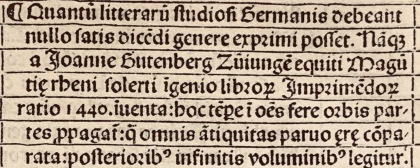
10) 319J Macer Floridus ( ascribed to) Odo of Meudon, Otto of Morimont )
Macri philosophi De uirtutibus herbarum et qualitatibus speciebus nouiter inuentus ac impressus.
Venetiis : Venetu[m] de Vitalibus.,1508. $6,000
Quarto full early vellum with guide letters, painted initials, antique hand glosses and some underlining, at the end of the volume a manuscript index of the plants described in the text. Some wormholes that in some cases affects the print in only a minor way. “The author of these Latin verses which describe the virtue of 80 herbs, took the name Floridus, not to be confused with Aemilius Macer” [L•S•O]
Proctor-Isaac; 12750; NLM: WZ 240: BM/STC Italian, p. 401; Brunet III, 1270; Hunt 22: Pritzel (2nd ed.); 571 The Medieval Herbal
11) 313J (pseudo Gregory I, Pope, approximately 540-604).
Expositio Beati Gregorij Pape super Cantica canticorum :cantica Gregori[i] sermone breui manifestat, dulcius vt castis auribus illa sonent.
Paris: Bertholdi Rembolt et Ioha[n]nis VVaterloes, 1508. $3,800
Octavo. Full vellum. The “expositio super Cantica Canticorum” is certainly a spurious work. A distinctive early-medieval reading of the Song of Songs would grow out of this Gregorian conception of pastoral care, encouraged by the lack of one complete, authoritative patristic commentary on the Song of Songs and the concerns of the exegetes themselves.
Adams; G-1181; Moreau,; I, p. 320, 84; Rosenthal, B.M. Printed books with manuscript annotations,; 59
12) The first medieval theologian to develop a systematic treatise on free will, the virtues, and the natural law.
245J Guillermus Altissodorensis, or William of Auxerre,
Summa aurea in quattuor libros sententiarum : a subtilissimo doctore Magistro Guillermo altissiodore[n]si edita. quam nuper amendis q[uam]plurimis doctissimus sacre theologie professor magister Guillermus de quercu diligenti admodum castigatione emendauit ac tabulam huic pernecessariam edidit.
Parisiis: Pigoucheti 3 Apr. 1500. $27,000
Folio, First edition. Large woodcut device on title, bound in a beautiful Contemporary Flemish blind stamped calf over wooden boards,
Goff G718; BMC VIII, 122 ; GW 11861; Proctor 8206 ; Polain 1787 ; Bod-inc G-295; Sheppard 6326; Pr 8206;
Us copies: Astrik L. Gabriel, Notre Dame IN, Boston Public, Bryn Mawr, Columbia, Huntington, Univ.of Chicago, Univ. of Wisconsin
13) 317J Guilelmus Parisiensis.
Postilla Guillermi in Euangelia et Epistolas de tempore de sanctis et pro de functis [sic] p[er] cursum anni : vnacu[m] biblie [et] marginalib[us] apositis co[n]cordantijs castigatissimo studio emendate.
NL/NP (Straßburg: Wilhelm Schaffner 1504/07. ?) $7,900 (“Mora” dated 1497 on leaf lxxxixb.)
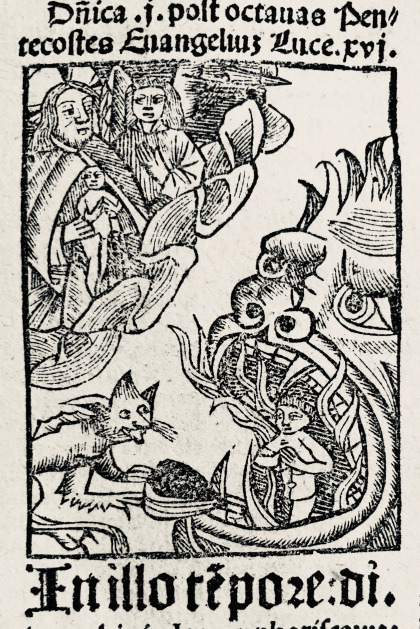
Quarto Two works bound as one in a newer vellum binding. “More than one hundred editions of the Postilla super epistolas et evangelia by Guillermus Parisiensis were printed during the fifteenth century. Surely this esteemed compilation must be regarded as one of the earliest ‘best sellers’, for how else can one explain why the text was not only frequently reprinted but was reissued time and time again by the same printer” F.W. Goff
GW dates about 1504-07 from the types.
BMC(Ger) dated about 1510.
Goff G 670; ca 1500
Assigned to Basel in Goff (“The Postilla of Guillermus Parisiensis,” Gutenberg-Jahrbuch 1959, p. 73) [Goff (P)#35.: ISTC ig00670000. Listing Bryn Mawr & Library Co of Philadelphia ; HC 8241*; VD16 E4379; Schr 4166;; IGI III p. 73; Sajó-Soltész p. 485; Voull(Bonn) 504; Pad-Ink 314; Kind(Göttingen) 2206a; BMC(Ger) p.117; BSB-Ink H-186; GW X Sp.504f. H 8241;. BSB-Ink H-186. Pell 5647. Schreiber 4166. BOD-Ink H-186.
14) 172J Heures [Vellum Printed Book of Hours (Use of Rome) In Latin and French]
Ces presentes heures a lusaige de Ro[m]me ont este faictes pour Simon Vostre Libraire domourant a Paris a la rue neuue nostre dame a le enseigne sainct Jehan l’evangeliste.
Paris [Philippe Pigouchet per] Simon Vostre, 16 Sept 1500. $21,000
Quarto full 18th century chagrin. Printed on Vellum wide margins Capitals supplied in Gold, Red and Blue
The “Sensuiuent les sept pseaulmes en françoys lacking (the second A 1-8 lacking “not surprisingly other copies are lacking the final ‘A’ quire). The present Horæ is illustrated with 22 full-page engravings in the text and numerous and smaller cuts, metal cut historiated and ornamental borders on every page, many with criblé grounds, depicting biblical scenes, the Virtues, the stag hunt, apple harvest and memento mori vignettes depicting including Pigouchet’s Dance of Death series (Claudin II, 53-53)
Goff H412; C 3106; Bohatta, H. Livres d’Heures;(1924) 730 = 705; Lacombe 109; Pell Ms 5892 (5878); Castan(Besançon) 554; Adams H1007; GW 13263. Listed copies: Cambridge UL, Oxford Bodley, Quebec Laval UL (vell), Besançon BM, Paris BN
NO copies in the US
15) 300J Johannes Sacro Bosco.
Figura sphere cu[m] glosis Georgii de Mo[n]teferrato artiu[m] [et] medici[n]e doctoris : gradiam [et] gloriam dabit dominus.
Venice [Jacobus Pentius, de Leuco] for Georgius de Monteferrato 1500, die 28 ianuarii. $11,000
Quarto, Later vellum. This is an illustrated incunable printed by Jacobus Pentius, de Leuce who started printing in 1495, his press was chiefly active after the turn of the century.
Goff J421; Klebs, A.C. Incunabula scientifica et medica,; entry 874.30; BMC V 566; HCR 14126; Essling 264; Sander 6668; Pell Ms 6718 (6683); Hillard 1153; Péligry 480; IGI 5353; Hubay(Augsburg) 1247; Pr 5705; GW M14661
16) 310. J Johannes de Sacro Bosco & ed. Francesco Capuano Di Manfredonia .
Sphera mundi nouit[er] recognita : cu[m] co[m]me[n]tarijs [et] authorib[us] in hoc volumine co[n]te[n]tis vz Capuano, Giovanni Battista Cichi Eschulani cum textu. Ioannis Baptiste Capuani. Jacobi Fabri Stapulensis. Theodosii de spheris cum textu. Michaelis Scoti questiones. Petri de Aliaco cardinalis q[uaesti]ones. Roberti Linconiensis Compendium. Theodosij iterum de spheris cum textu. Tractatus de sphera solida. Theorice planetarum conclusiones cum expositione. Campani Tractatus de sphera. Eiusdem tractatus de computo maiori. Joannis de monte regio in cremone[n]sem disputatio. Theorice textus cu[m] Joa[n]nis Baptiste Capuani exp[ositi]one. Ptolomeus De speculis. Theorica planetarum Joannis Cremonensis, plurimum faciens ad disputationem ioannis de monte regio, qua[m] in aliis hactenus i[m]pressis non reperies.
Venetijs: Luce antonij de giu[n]ta …,1518. $7,000
Folio. Original vellum. Resonances between Capuano’s commentary and Copernicus’s DE revolutionibus, I, 5-11, suggest the hypothesis that Copernicus is answering Capuano, whose work was owned by Joachim Rheticus, if not Copernicus himself.”1 The authors who Capuano choses gives us a good picture of the state of teaching Astronom in the late 15th century.” Shank (2009)
Houzeau / Lancaster I, 1642. EDIT 16 CNCE 29259. STC 597. Essling 1975. – Not in Adams.
17) 314-J. Leo I Magnus. Pope & Jacobus Lefèvre d’Étaples.
Leonis pape: hoc est pontificis maximi & sanctissimi Epistolae catholicae & sanctae eruditio[n]is plenissim[a]e
[Paris] :Iodoco Badio Ascensio. 1511. $3,400
Folio (Missing fol. CII [N3]) Bound in modern vellum.
Pope Leo I focused his pontificate on four main areas. He continuously worked to oppose and root out numerous heresies which were threatening the Western Church. Among them were Pelagianism, which involved denying Original Sin and failing to understand the necessity of God’s grace for salvation. This Roman aristocrat was the 1st pope who was given the epithet “the Great” and besides Gregorius I (540-604), the most important pope of Christian antiquity.
BM STC French,; 1470-1600, S. 262; Moreau II,; 146; Renouard, Imprimeurs & libraires parisiens du XVIe siècle,; Bade-168
18) 957G Richard Mediavilla [Middleton], d. 1302/3
Commentum super quartem Sententarium.
Venice: Christophorus Arnoldus, [circa 1476-7] $22,000
Folio {320 leaves complete} Second edition. This copy is rubricated throughout with nicely complicated red initials. Bound in modern calf over wooden boards.
Goff M-424; BMC V 206; HCR 10985; BSB-Ink R-169.050; GW M22505 :
ISTC im00422800 shows two US copies: St Louis Univ., Pius XII Memorial Library (-) & YUL – i.e. both defective. UCLA, Has a complete copy listed in their catalogue.
19) 303J Nicolaus de Orbellis
Eximii doctoris magistri Nicolai de Orbellis sup[er] se[n]te[n]tias co[m]pe[n]diu[m] Se[n]te[n]tias Compendiu[m] p[er]utile :elega[n]tiora doctoris subtilis dicta summatim co[m]plectens quod dudu[m] multis viciatu erroribus: castigatissime fuit recognitu: ac noue impressioni in: elegantiora doctoris subtilis dicta summatim complectens: quod dudu[m] multis viciatum erroribus: castigatissime fuit recognitu[m]: ac nove impressioni in Parisii commendatum.
Paris In vniuersitate parisia : Impressioni datus, studio et opera Johanis Barbier impressoris, expe[n]sis vero Johannis Petit, undated ca 1500. $3,500
Octavo .Original blind stamped calf -rebacked. Lacking final leaf. This is a commentary on John Duns Scotus’ commentary on Peter Lombard’s ‘Sententiæ’. Adams, O251;
20) 316J Nicolaus de Orbellis.
Eximii Doctoris Magistri Nicolai de Orbellis super Sententias compendiu[m] p[er]utile : elega[n]tiora doctoris subtilis dicta summatim co[m]plectens, quod dudu[m] multis viciatu[m] erroribus : castigatissime fuit recognitu[m], ac noue impressioni in Hagenarv co[m]mendatum.
(Hagenaw, impressum opera industrij Henrici Gran expensis Iohannis Rynman de Oringaw, 1503). $1,100
Quarto Lacks 11 leaves. Nicolas de Orbellis’ commentary on John Duns Scotus’ commentary on Peter Lombard’s Sententiae./ Imprint from colophon./. Bound in flexible contemporary parchment.
Adams; O249; Panzer VII, 68, 15; VD16- J 549 ; Adams O-249, CGBNP 127-561, NO 0110834, VD16 J-549; Benzing, J. Bib. Haguenovienne,; p. 11, no. 25
21) 277J Paulus Orosius
Historiae adversus paganos, edited by Aeneas Vulpes.
[Vicenza]: Hermannus Liechtenstein, [c.1475]. $ 15,000
No signatures: 100 leaves unnumbered.
In this copy there is a large opening initial in green, red, blue, and yellow, with floral extensions in the margin, other initials in red, some in blue, initial spaces, most with guide letters, rubricated. Full modern vellum. The Second edition of Orosius’s universal history, written to counter the prevailing belief among non-Christians that disasters which had befallen civilisation were the result of the pagan gods, angry with worshippers turning to Christianity.
Goff O-97; H *12099; GW M28420; BMC VII 1035; Bod-inc O-027; BSB-Ink O-82; ISTC io00097000; Goff O-97
22). 305J Pelbartus de Themeswar
Sermones Pomerii fratris Pelbarti de Themeswar diui ordinis sancti Francisci de Sanctis: Jncipiunt feliciter.
Hagenau : Heinrich Gran, for Johannes Rynman, 30 September, 1501.
[imp[re]ssi … p[er] industriu[m] Henricu[m] Gran i[n] imp[eri]ali oppido Hagenaw: expe[n]sis ac su[m]ptib[us] p[ro]uidi Joha[n]nis Rynman Finiu[n]t feliciter: Anno …millesimoq[ui]nge[n]tesimoprimo. vltimo die Septe[m]bris] $22,000
Folio Original binding calf over wooden boards. (Extensive provenience is available) As early as the 15th century, Haguenau became the second home, after Strasbourg, to distribute the printing press in Alsace. It was introduced in 1489 by Henri Gran.
Not in Goff, ISTC No.ip00252500; Hain 12557*; VD16 P1165; NO copies in the US
23) 238J Peregrinus of Opole ,) Jacobus de Voragine , Nicolaus de Dinkelsbuel Peregrinus: Sermones de tempore et de sanctis. Add: Jacobus de Voragine: Quadragesimale. Nicolaus de Dinkelsbuel: Concordantia in passionem dominicam
Est autem huius operis ordo talis. Primo ponuntur sermones d[omi]nicales de tempore per anni circulu[m]. Secundo de sanctis, Tercio q[ua]dragesimale Jacobi de Foragine, Q[ua]rto concordantia quatuor euangelista[rum] in passiiones d[omi]nicam a magistro Nicolao Dinckelspubell collectam.” At end of leaf m8: “Sermones Peregrini de tempore finiunt.
[Ulm: Johann Zainer, not after 1479] (A copy now in Munich BSB has an ownership inscription dated 1479) $14,000
Folio Original calf over wooden boards.
Only two North American copies, both defective.
Harvard University (- ff 189-278) Bryn Mawr College, (ff 239-278)
Goff P267; HC 12581*; C 4407; IGI 7404; IBP 4241; Madsen 3083; Voull(B) 2629,5; Hubay(Augsburg) 1582; Hubay(Eichstätt) 794; Borm 2059; Walsh 909; Rhodes(Oxford Colleges) 1340; BMC II 529; BSB-Ink P-183; GW M30917 – Wegener, Zainer 9 – BSB-Ink P-183 – Proctor 2542 ISTC ip00267000
24) 145J Paulus Pergulensis
Logica magistri Pauli Pergulensis.
Venice: Johannes Emericus, de Spira, 1495/96. $12,500
Quarto. 10 x 8 ½ inches. a-e8, f44 of 44 leaves (complete)
Signature of Thomas Stewart, Knight of St. John of Jerusalem, dated Rome 1837 on title. Bound in early 19th-century quarter sheep; light damp staining in lower margins throughout, title and last page soiled.
Goff P195; H 12626; R 1314; Sander 5476; IBE 4363; IGI 7322; IBPort 1357; Horch(Rio) Suppl 13; Mendes 957; GW M30234US Copies (Princeton Univ (2) and The Newberry Library) Not in Copinger or British museum Catalogue of books printed in the XVth century.
25) 318J
Stella clericorum cuilibet clerico summe necessaria
[Leipzig] : [Conrad Kachelofen], before 1492. $4500
Quarto Bound in modern boards. Initals supplied in read and internal capitals stroked. This copy is lacking the final leaf comprising the poem” Aspice presentis”

“One of the forgotten works of the Middle Ages is the Stella clericorum, Though short, often derivative in content, and generally rather unassuming, the Stella clericorum was nonetheless one of the most popular traetises of the later Middle Ages. Stella clericorum communicates, in simplistic form and for the use of lower clergy, many of the grand ecclesiological and ritual accom- plishments of the twelfth century. Its principal themes are the dignity of the priesthood and the importance of the Eucharist.”. (CAROL NEEL, Colorado College 1997)
Goff S 775. ISTC is00774800/ (listing Huntington & Newberry only )IBP 5110. H 15065; BSB-Ink S-578; IG 2522;H 15065*; IBP 5109; Sajó-Soltész 3142; Coll(S) 999; Voull(Bonn) 1091; Günt(L) 1348; Hubay(Würzburg) 1954; Ohly-Sack 2590; Borm 2522; [The copy in München BSB has an owner’s inscription with the date 1492]
26) 35J Nicolaus Tygrinus or Tegrinus or Tegrini
Lucensium Oratio Luculentissima Pont. Maximo Alexandro Sexto per Nicolaum Tygrinu[m] Lucensem Vtriusq[ue] Iuris.
[Rome], [Andreas Freitag ],15 October 1492 $5,900
Quarto, First edition, Modern roan boards. Oration such as this are usually rare and short this one is both it is a tribute from the City of Lucca to the election of Pope Alexander VI.
CF Bühler, The Earliest Editions of the “”Oratio”” (1492) by Nicolaus Tygrinus (in: Gutenberg JB 1975, pp. 97-99)” Goff T563; HC 15751*; Pell Ms 10972; CIBN T-51; Nice 209; IGI 9670; IBE 5542; BMC IV 137;
27) 246J Gerardus de Zutphania
[ De spiritualibus ascensionibus.]
Tractatus de spiritualibus ascensionibus Add: David de Augusta: De exterioris et interioris hominis compositione Lib. II, 1 (De quatuor in quibus incipientes deo servire debent esse cauti)
[Basel : Amerbach and Petri de Langendorff, not after 1489]. $6,000
Octavo 67 of 68 leaves. Lacking a1 title. Rubricated in red, initials painted in red, blue and green. Contemporary binding in full calf, with blind tooling, spine slightly rubbed Final leaf blank. “the most fertile and the most successful writer the Brothers [of the Common Life] ever produced.” “Zerbolt outlines how one can redeem the soul from its fallen state, moving to higher and higher levels through “self -knowledge, repentance, combat of sin, mortification, the practice of humility and obedience.”
(Post “The Modern Devotion”)
Goff,; G177;ISTC,; ig00177000; Oates,; 2803; Bod-inc,; G-081; Pr,; 7638; BMC,; III:752; BSB-Ink,; G-127; GW,; 10689
James Gray Booksellers LLC C. 617-678-4515
[email protected] No.1
My first ‘Short title catalogue’ (No1) The reason for publishing a short catalogue is to facilitate easier and cheaper shipping so that I can ship anyone who asks for one will get one quickly.
0 notes